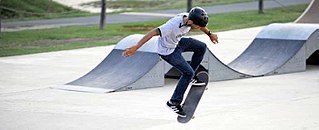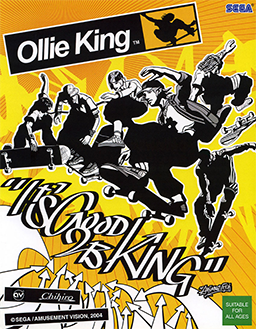Related Research Articles

A skateboarding trick, or simply a trick, is a maneuver performed by manipulating a skateboard, usually with one's feet, in a specific way to achieve the desired outcome – the trick.

The kickflip is a skateboarding trick, in which the rider flips their skateboard 360° along the axis that extends from the nose to the tail of the deck. When the rider is regular footed the board spins counter-clockwise if viewed from the side.

An Indy grab, also known as an Indy air, is an aerial skateboarding, snowboarding and kitesurfing trick during which the rider grabs their back hand on the middle of their board, between their feet, on the side of the board where their toes are pointing, while turning backside. This trick is done only backside; the same maneuver done while turning front side, is called a front side air. The Indy grab is a generic skateboarding trick that has been performed since the late 1970s. This trick is performed mainly while vert skating, e.g. on halfpipes. Although this move can be done on flat land, it is much easier on a ramp. The Indy grab is one of the basic tricks in vert skating and is usually combined with spins, kickflips and heelflips.

Longboarding is a variation of skateboarding typified by the use of longer boards ("decks") with longer wheelbases and softer wheels. While longboards vary widely in shape and size, compared to street skateboards longboards are designed to be more stable at speed and to have more traction due to larger wheel sizes and softer wheel durometers. While standard street skateboards may typically be between 28 and 34 inches long, longboards can range anywhere from 32 to 50 inches in length. Ride characteristics of longboards generally differ from that of street skateboards due to the use of specialized longboard trucks that have different properties than those typically used with skateboards; while street skateboards use "traditional kingpin" (TKP) trucks that are optimized for tight turning radii, ollie and flip tricks, slides, grinds, and transition skating, longboards are typically paired with "reverse kingpin" (RKP) trucks that are designed for increased stability at higher speeds, more "surfy" carving characteristics, and/or greater ride comfort for commuting over longer distances.

The ollie is a skateboarding trick where the rider and board leap into the air without the use of the rider's hands. It is the combination of stomping, also known as popping, the tail of the skateboard off the ground to get the board mostly vertical, jumping, and sliding the front foot forward to level out the skateboard at the peak of the jump.
In human biology, footedness is the natural preference of one's left or right foot for various purposes. It is the foot equivalent of handedness. While purposes vary, such as applying the greatest force in a certain foot to complete the action of kick as opposed to stomping, footedness is most commonly associated with the preference of a particular foot in the leading position while engaging in foot- or kicking-related sports, such as association football and kickboxing. A person may thus be left-footed, right-footed or ambipedal.

A bertslide, Bertlemann slide, or bert, is a skateboarding trick where the skateboarder puts one hand on the ground and rotates the board while it is still on the ground, effectively sliding on the wheels of the skateboard. The trick was named after the surfer Larry Bertlemann, who first performed the trick on a surfboard, then later incorporated it into his skateboarding. The original version of the trick was a 180-degree turn. The Z-Boys, an influential group of mid-1970s skateboarders, adapted the move by extending the slide to 360 or even 540 degrees.

The benihana is an aerial trick performed on a skateboard.
In surfing, skateboarding, snowboarding and aggressive inline skating, frontside and backside are terms that are used to describe how a person approaches an obstacle or performs a certain trick. In aggressive inline skating, frontside and backside are types of grinds.
Casper is a freestyle skateboarding trick that was invented by Bobby "Casper" Boyden in the late 1970s. Boyden had a very pale skin and he was nicknamed after the cartoon ghost. The modern casper was invented by Rodney Mullen in the late 1980s.

Freestyle BMX is bicycle motocross stunt riding on BMX bikes. It is an extreme sport descended from BMX racing that consists of five disciplines: street, park, vert, trails, and flatland. In June 2017, the International Olympic Committee announced that freestyle park was to be added as an Olympic event to the 2020 Summer Olympics.

Flatland is a freestyle BMX riding style performed on smooth flat surfaces that do not include any ramps, jumps, or grindrails. It is sometimes described as a form of artistic cycling with a blend of breakdancing.
A freestyle skateboarding trick is a trick performed with a skateboard while freestyle skateboarding. Some of these tricks are done in a stationary position, unlike many other skateboarding tricks. The keys to a good freestyle contest run are variety, difficulty, fluidity, and creativity. This is an incomplete list, which includes most notable tricks.
A flip trick is a type of skateboarding trick in which the skateboard rotates around its vertical axis, or its vertical axis and its horizontal axis simultaneously. The first flip trick, called a kickflip but originally known as a "magic flip", was invented by professional skateboarder Rodney Mullen.

A slide is a skateboarding trick where the skateboarder slides sideways either on the deck or the trucks.

In skateboarding, a nollie, short for "nose ollie", is an ollie executed at the front of the board while the rider is positioned in their natural stance. Professional skateboarders Karl Watson, Shuriken Shannon, Tuukka Korhonen, and Sean Malto have been recognized for their ability to perform the nollie trick. A nollie can be easily confused with a fakie ollie, whereby the rider uses their original foot position but is instead riding backwards.

A caster board, vigorboard or waveboard is a two-wheeled, human-powered land vehicle. Other names are J-board and RipStik, both of which are derived from commercial brands.

A shove-it is a skateboarding trick where the skateboarder makes the board spin 180 degrees without the tail of the board hitting the ground under their feet. There are many variations of the shove-it but they all follow the same principle: The skateboarder's lead foot remains in one spot, while the back foot performs the "shove". The pop shove-it was originally called a "Ty hop", named after Ty Page.

Ollie King is an arcade skateboard racing game developed by Amusement Vision and published by Sega for the Sega Chihiro hardware in March 2004 following limited location tests in late 2003. The game was revealed at Tokyo's JAMMA Arcade Show in 2003. A spiritual successor to Top Skater, it was created by the same team that developed Jet Set Radio.
References
- ↑ Grosso, Jeff. "Professional Skateboarder". Archived from the original on 2021-12-14.
- ↑ Mastering Skateboarding by Per Welinder & Pete Whitley (Human Kinetics 1, 2011)
- ↑ Skateboarding Step-By-Step by Charlotte Stock & Ben Powell (Rosen Publishing Group, 2009)